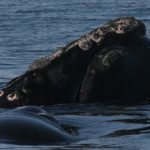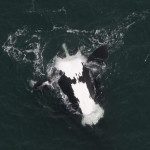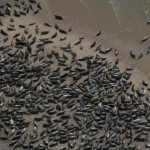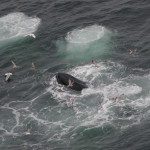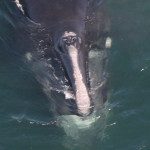March 2008
24 March. Departing from Chatham, we flew up the backside of Cape Cod where we saw fin, humpback, and minke whales! Coming into the bay, we found first one right whale and then another… all aggregated in the northeast of the center of the bay. Many of the whales were going on long dives, remaining submerged for fifteen minutes or more! We also saw several right whale surface active groups (SAGs), including one upside down whale with a brilliant white pattern on it’s belly.
18 March. After seeing two entangled right whales on Friday, we hoped to get back in the air as soon as possible. Weather forecasts did not look promising, and on Tuesday morning we decided that this might be our only chance this week, so we took off from Chatham airport, despite an iffy weather forecast. Fortunately, the winds started to die down and we were able to complete a full survey of Cape Cod Bay and even do a quick flyover of Jeremy Point for the Riverhead Foundation’s annual seal census.
We located five right whales in Cape Cod Bay, including a SAG or “surface active group†between Wood End and Herring Cove Beach in Provincetown. The SAG was comprised of three adult whales who were slapping their large, black flippers on the surface of the water and rolling on their backs. One of them even had a bright white belly! Continuing with our survey, we eventually found ourselves north of Race Point, trying to distinguish between three different species of baleen whale! Several sleek fin whales lunged through a school of fish, while humpback whales fed, using columns of bubbles to trap and confuse the fish. Unlike humpback and fin whales, who generally feed on small schooling fish, right whales feed on flea-sized zooplankton. The two right whales did not appear to be feeding, but the presence of multiple species in a given area suggests that this could be a highly productive area.
14 March. On the morning of March 14th, Shearwater R/V and the Habitat Studies Team cruised out of Provincetown Harbor, into Cape Cod Bay. With optimal weather and sea conditions the cruise was off to a great start. In response to higher numbers of right whales in the Bay, the team wanted to gain a better understanding of where the food resources were located in the water column. To do so, a vertical pump was used to attain vertical profiles of zooplankton near a large group of right whales, off of Wood End. 66 vertical plankton samples were taken in the vicinity of right whales. At mid-morning the plankton appeared to be located at nine meters and just above the seafloor (40 meters); this corresponded with the right whales’ fluking (diving) behavior, since they were probably subsurface feeding, and at depth, where a very dense engybenthic (associated with the seafloor) layer of pseudocalanus species had formed. A little later in the day, a shallow vertical sample showed that the layer previously around 9 meters depth was no longer there; the habitat team hypothesized, though, that the dense layer persisted at depth. Toward the end of the day, this dense engybenthic layer split to form a new layer near the surface, between zero and two meters. This movement of the food resource corresponded with a change in right whale feeding behavior; the whales commenced to skim feed! Skim feeding is a feeding behavior associated with right whales, during which the animals swim through a surface layer of plankton with mouths agape. The plankton that is above 333 microns in size is caught in the whales’ baleen, while those smaller then that are filtered out. The team documented 23 right whale sightings in that part of the Bay alone (with some duplicates). Towards the end of the cruise a Surface Active Group, or SAG, was sighted. In following cruises, the habitat team hopes to begin exploring physical drivers that direct zooplankton movement through the water column, and the effect that these migrations may have on right whale behavior.
14 March. We began our aerial survey at the northern end of Cape Cod Bay and flew several track lines without a right whale in sight, although we did see a fin whale and two minke whales. Then we came upon the aggregation of right whales, clumped closely together off of Wood End in Provincetown. The whales were engaged in a variety of behaviors, but most were fluking up and remaining submerged for long periods of time, behavior indicative of foraging at depth. Among these right whales was “Wart†(also known as EGNO 1140), an adult female we have seen in the bay several times this month entangled in fishing rope. We contacted the PCCS disentanglement team who was able to remove some of the trailing rope to minimize the chances of it getting caught further on her flukes or flippers. After assisting with the disentanglement effort, we returned to the Chatham airport to refuel. Once we arrived back in the bay, we continued to document the right whales in the area, and came upon yet another entangled right whale. Luckily, the disentanglement team was still on the water and they were quickly on the scene. The whale was identified as EGNO 1980, an adult male right whale, and the disentanglement team was able to better assess his health and document his entanglement. There was a noticeable change in the behavior of the right whales in the bay as the afternoon progressed, with more and more whales beginning to skim feed at the surface- quite a sight!
11 March. We took off from Chatham this morning with high hopes for beautiful weather out on Cape Cod Bay. As we began our survey in the southern portion of the bay, we were disappointed to see that the winds were not as calm as predicted. With a Beaufort Sea State of 5, it can be very difficult to reliably detect right whales amidst all of the white caps and frothy water. Just as we were about to call it a day and head back in, the winds finally started to settle down. We completed our first seven tracklines without seeing a single marine mammal. About two-thirds of the way through our eighth trackline, we broke track for a sighting of two right whales. We soon realized that there was a large concentration of right whales clumped in small geographical area. We began to make our way from whale to whale, systematically documenting the location and behavior of each whale, and obtaining photographs for identification. The whales were engaged in a variety of behaviors including subsurface feeding and SAGs. With so much activity in the bay, we decided to land to refuel the airplane midway through our flight. When we reached the bay again, we were thrilled to see that the winds had dropped and the water was calm. We headed straight into the group of whales to make sure we hadn’t overlooked any of them, and came upon a right whale with rope trailing out of the baleen and alongside the body. We immediately began to document the details of the entanglement and contacted the PCCS Disentanglement Team. The whale was recognized as EGNO 2645, the whale we had seen entangled in Cape Cod Bay on January 12th. The rest of the afternoon was spent photographing the entangled whale and assisting in the disentanglement effort. At one point, while searching the area for EGNO 2645 amidst all the other right whales, we were alarmed to realize that we had a second entangled right whale in the area. The whale was soon recognized as EGNO 1140 (also known as “Wartâ€) who we had seen entangled in the bay last Thursday. Efforts throughout the afternoon resulting in getting thorough photo documentation of each entangled whale, and the disentanglement team aboard R/V Ibis was able to get a sample of the rope attached to EGNO 2645.
07 March. Under graying skies, R/V Shearwater steamed out into Cape Cod Bay, not knowing what to expect; an entangled right whale had been found the previous day. The habitat team made its usual station stops and conducted the usual surface and oblique tows. At station 6M, in the mid-east of the Bay, the team found itself approaching a group of at least six whales North Atlantic right whales, not necessarily associated, but more or less aggregating in the area. While the plankton samples indicated no dense resource close to the surface, these whales appeared to be bottom-feeding on a dense bottom layer of, according to our samples, predominantly pseudocalanus species. As the cruise drew to a close, the team decided to make a stop at a station not usually sampled: 6N. The surface sample revealed a rich pseudocalanus species resource, though no whales were exploiting it yet; perhaps they had not yet located it? This finding gave the habitat team hopes of seeing skim feeding in the near future.
06 March. We began our survey today by flying up the coastline on the backside of Cape Cod where we encountered one lone minke whale. We entered Cape Cod Bay from the North and began to make our way down through the bay searching for the telltale signs of right whales. Soon we spotted a single adult right whale. No sooner had we photographed that whale, when we came across another single right whale. Ten minutes later, there was a third right whale! This one seemed to be traveling somewhere in a hurry, and we soon saw lots of surface activity up ahead… the whale was racing toward another group of right whale engaged in a surface active group (SAG). The whales were rolling and splashing at the surface, and one whale was belly up. As we circled the aircraft around the group of whales trying to determine how many individuals were involved in the SAG and obtain ID photographs, we came across another right whale swimming alone nearby, and then another! Clearly this small geographic area was a hotspot for right whales today. Unfortunately, the last whale we saw had fishing rope trailing out of the left side of her mouth… we immediately abandoned our survey effort and focused our attention on the entangled right whale. We contacted the PCCS disentanglement team who raced to the scene. We were able to track the entangled whale for several hours, but the whale’s evasive behavior and fading daylight did not permit the attachment of a tracking buoy.

Our Work
Humpback Whale Research
Right Whale Research
Marine Animal Entanglement Response
Marine Geology Department
Water Quality Monitoring Program
Marine Fisheries Research
Seal Research
Shark Research
Marine Education
Interdisciplinary
Marine Debris and Plastics Program
Marine Policy Initiative
Cape Cod Climate Change Collaborative
Publications

